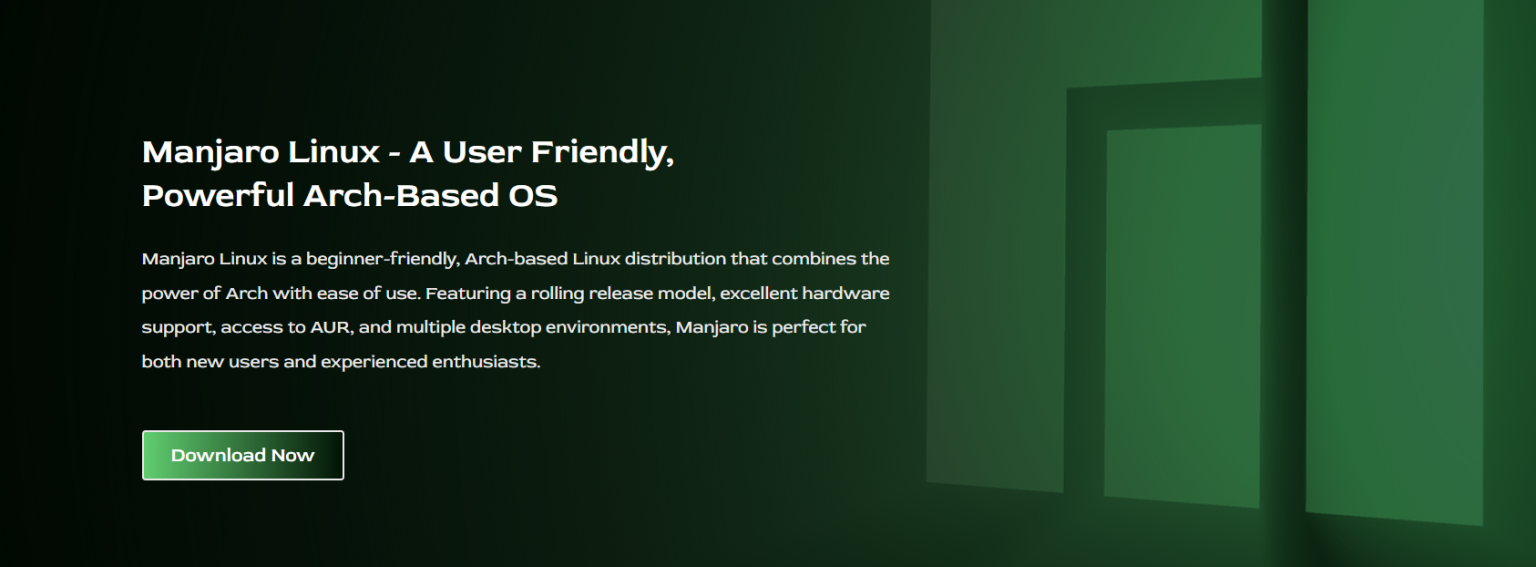The Linux ecosystem comprises diverse distributions, each offering its unique advantages. While some are built for stability and others for bleeding-edge innovation, very few strike a perfect balance between the two. Manjaro Linux does precisely that. It delivers the performance of Arch Linux while being accessible and stable enough for daily users, making it a standout choice.
Many Linux users are drawn to Arch because of its flexibility, but the manual setup and maintenance can be daunting. Manjaro Linux combines the best aspects of Arch with simplicity, preconfigured tools, and a smooth graphical interface. This makes it suitable for both Linux newcomers and advanced users who want a plug-and-play Arch-based system.
This article breaks down the core elements that separate Manjaro Linux from other Linux distributions. From its rolling release structure to its extensive desktop support and hardware compatibility, you’ll discover what truly makes Manjaro Linux unique in the open-source world.
Is Manjaro Based on Arch Linux?
Arch Power with Beginner Simplicity
Built on Arch, Manjaro Linux inherits a fast, modular foundation. However, unlike Arch’s complex manual installation, Manjaro delivers a ready-to-use system that doesn’t require hours of setup or extensive technical knowledge. It eliminates the need for building everything from scratch and instead offers a preconfigured desktop that works out of the box.
Here’s how Manjaro simplifies the Arch experience:
- Provides a graphical installer that handles disk setup, users, and partitions with ease
- Installs essential software, drivers, and desktop environments automatically
- Offers pre-configured system settings suitable for everyday users
Preconfigured for Productivity
Right after installation, users get a complete desktop experience with essential tools, themes, and drivers. Manjaro Linux eliminates the need for post-install tweaks, allowing users to start working immediately.
Access to Arch’s Rich Ecosystem
Despite these user-friendly changes, Manjaro Linux retains compatibility with the Arch User Repository (AUR) and core Arch repositories. This gives users access to thousands of packages and bleeding-edge tools within a safe, managed environment.
How Does Manjaro Handle Software Updates?
Rolling Release That’s Stable
Operating on a rolling release model, Manjaro Linux ensures users always get the latest software and features. However, unlike Arch, these packages are tested in multiple stages to avoid instability and system-breaking bugs.
Update Pipeline with Safety Checks
Each update moves through three layers: Unstable, Testing, and Stable. This structure gives Manjaro Linux the flexibility of a rolling release while preserving system reliability for daily use.
Flexibility in System Management
Users can easily control updates through graphical tools like Pamac. Features like Timeshift make it possible to create backups before updates, ensuring quick recovery in case of any issues.
What Desktop Environments Are Offered?
Variety for Every User
Manjaro Linux provides three official desktop environments: Xfce, KDE Plasma, and GNOME. Each edition is carefully tailored for performance, aesthetics, and usability. Xfce is fast and minimal, KDE is modern and highly customizable, while GNOME offers a sleek, distraction-free experience.
Community Editions Expand the Options
Beyond the core editions, Manjaro Linux also offers community-supported desktops such as Cinnamon, MATE, Budgie, LXQt, Openbox, and i3. These options allow users to fine-tune their system based on personal preference or hardware capabilities.
Consistency Across Editions
Regardless of the chosen environment, Manjaro Linux maintains consistency in updates, package access, and support. This unified structure helps users switch environments without relearning the system.
How Easy Is It for Beginners?
Smooth Graphical Installation
Thanks to the Calamares graphical installer, setting up Manjaro Linux is a streamlined process. Users are guided through each step clearly, making it approachable even for those who have never installed Linux before.
Here’s what makes it beginner-friendly:
- A clean, intuitive layout with step-by-step guidance
- Support for automatic partitioning or manual disk control
- Pre-installation previews to avoid misconfigurations
Tools That Simplify Management
Essential utilities, such as Pamac (for package management) and MHWD (for hardware detection), come pre-installed. This removes the need for complex command-line input, making system management much easier for beginners.
Welcoming Community Support
From official forums to YouTube tutorials and community wikis, Manjaro Linux provides beginners with accessible help and learning resources. Users don’t have to feel lost when getting started.
What About Hardware Compatibility?
Automatic Detection and Configuration
The MHWD tool in Manjaro Linux automatically detects hardware components and installs the necessary drivers. This feature ensures that your system is ready to use without needing manual driver setups.
One-Click Proprietary Driver Support
Whether it’s an NVIDIA GPU or a Broadcom wireless card, Manjaro Linux simplifies the process of installing proprietary drivers. The graphical driver manager makes it as easy as selecting and applying the change.
Broad Compatibility for All Devices
Manjaro Linux performs well across a wide range of hardware. From high-end gaming rigs to older laptops, its performance is consistent, reliable, and optimized out of the box.
How Does Manjaro Compare to Other Popular Distros?
A Smarter Alternative to Ubuntu
While Ubuntu is known for stability and enterprise support, Manjaro Linux offers newer software through rolling releases and more control over system components. It also provides better performance tuning and package availability via the AUR.
Key differences include:
- Rolling release updates ensure access to the latest features without needing a full OS upgrade
- Pamac package manager delivers a smoother experience compared to Ubuntu’s APT-based options
- Manjaro’s built-in tools offer easier driver installation and kernel management
- Users get direct access to AUR, Flatpak, and Snap, offering wider software availability
More Modern Than Linux Mint
Linux Mint is ideal for users who want a traditional desktop with long-term support, but Manjaro Linux offers fresher software and more choices in desktop environments. It also supports newer kernels more quickly, making it ideal for users with the latest hardware.
Better Balance Than Fedora
Fedora is powerful but sometimes suffers from abrupt changes and limited desktop options. Manjaro Linux offers a more controlled upgrade path with multiple desktop environments and better community responsiveness.
What System Tools Set Manjaro Apart?
Pamac for Effortless Package Management
Manjaro Linux includes Pamac, a graphical package manager that supports native packages, AUR, Flatpak, and Snap. It gives users complete control without requiring terminal commands.
Built-In Backup and Snapshot Tools
With Timeshift integration, users can create system snapshots before major changes. If something goes wrong, Manjaro Linux allows fast rollback to a previous working state, ensuring peace of mind.
Kernel Manager for Advanced Control
Users can easily switch between multiple Linux kernel versions using the built-in Kernel Manager. This helps troubleshoot compatibility issues and lets users fine-tune performance based on their hardware.
How Active and Helpful Is the Manjaro Community?
Supportive and Responsive Forums
Manjaro Linux has an active community that helps users solve issues quickly. From official forums to Reddit and Telegram channels, help is just a post away.
Transparent Development Communication
The Manjaro team regularly communicates updates, changelogs, and future plans with its community. This transparency builds trust and keeps users informed at every step.
Contribution-Driven Growth
Many features in Manjaro Linux are shaped by user feedback and contributions. The community has a direct impact on how the distribution evolves over time.
Is Manjaro Good for Developers and Power Users?
Advanced Software Access
With full access to AUR, development tools, and the latest packages, Manjaro Linux is a powerful environment for programmers, system administrators, and tinkerers.
Tiling Window Manager Support
Manjaro’s i3 edition provides a keyboard-driven, efficient workspace designed for speed and multitasking. It’s ideal for power users who want complete control over their setup.
Complete Customization
From scripting to kernel switching and package tweaking, Manjaro Linux gives users the freedom to shape their system as they see fit, without the limitations found in more rigid distributions.
Why Do Users Prefer Manjaro Over Others?
Cutting-Edge Software That Works
By combining rolling releases with a safety buffer, Manjaro Linux delivers modern features without constant bugs. It offers the best of both stability and innovation.
Designed for Everyone
Whether you’re new to Linux or an experienced user, Manjaro Linux provides the tools, environments, and performance you need—right out of the box.
Freedom Without Frustration
Unlike distros that either limit control or overwhelm with complexity, Manjaro Linux hits the perfect middle ground. It offers freedom, speed, and simplicity, all in one distribution.
Conclusion
What truly sets Manjaro Linux apart from other distributions is its ability to combine the raw power of Arch with unmatched usability and flexibility. It removes the technical barriers of traditional Arch systems while maintaining access to cutting-edge software, reliable tools, and extensive customization. With robust desktop options, hardware compatibility, a welcoming community, and thoughtful development, Manjaro Linux continues to stand out as a distribution built for both everyday users and professionals.

